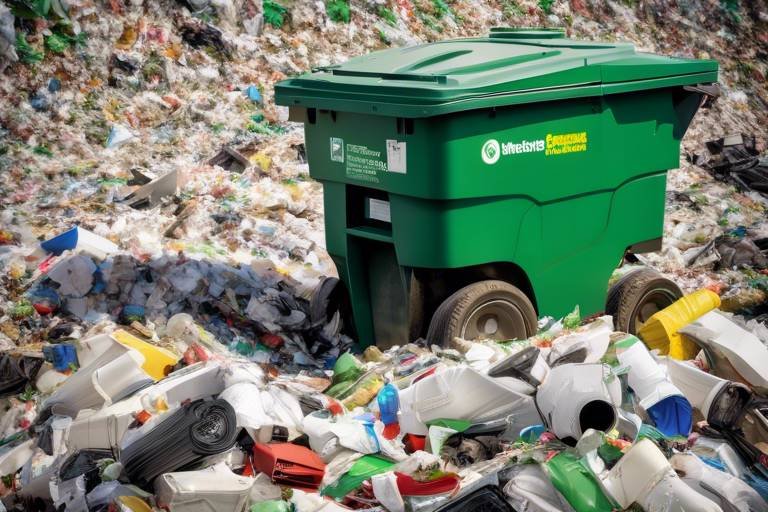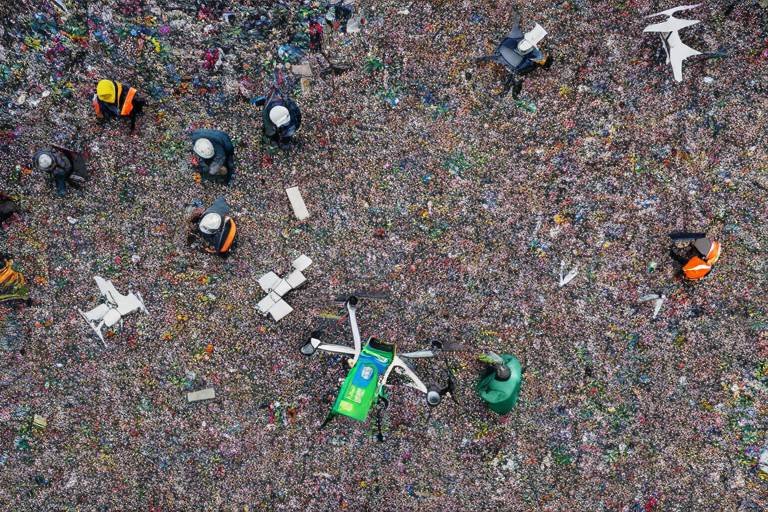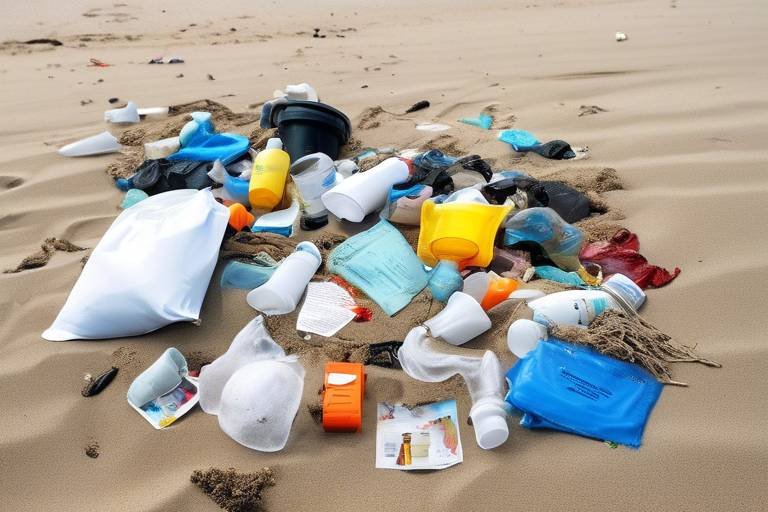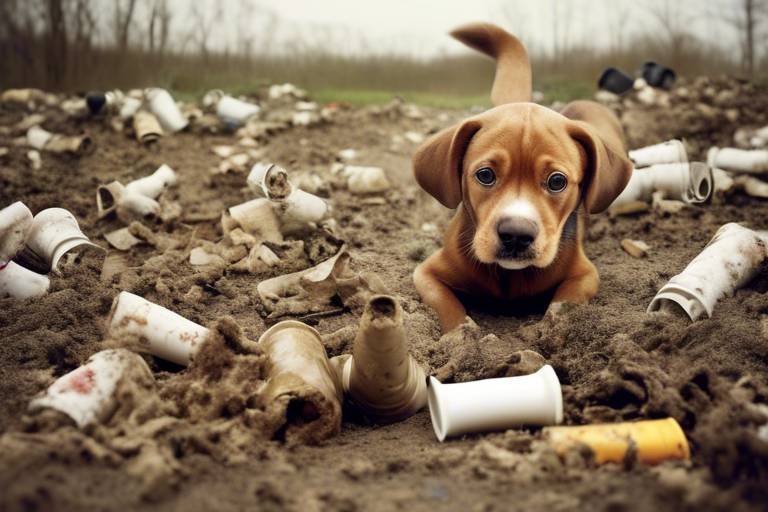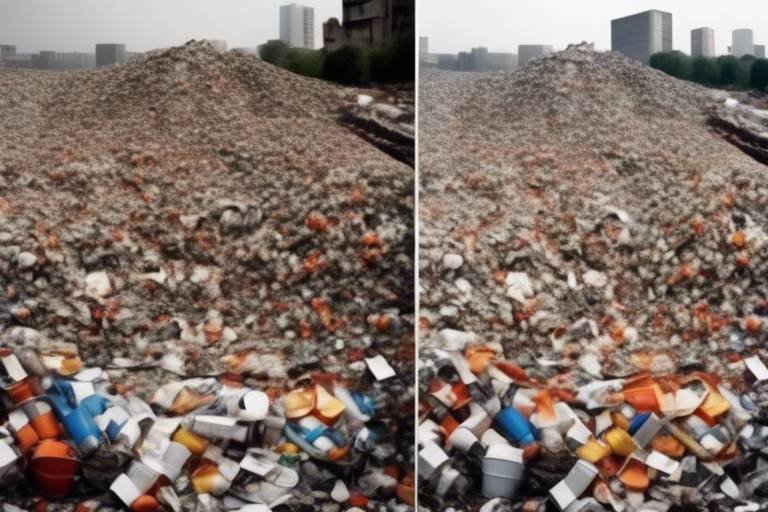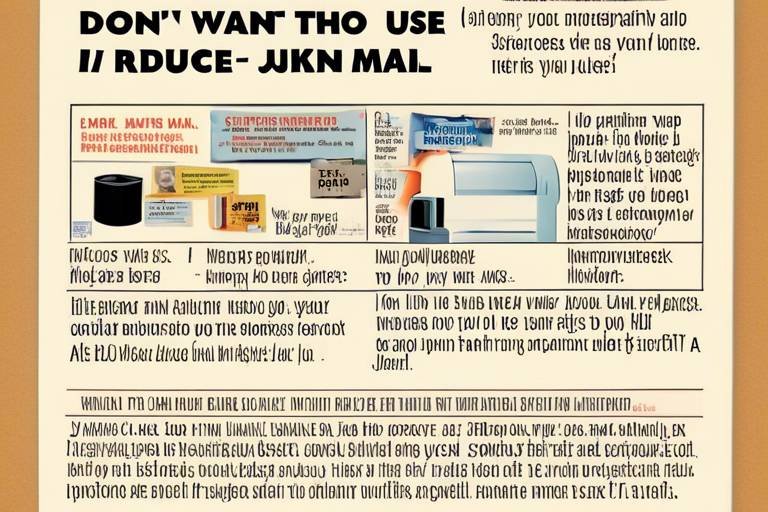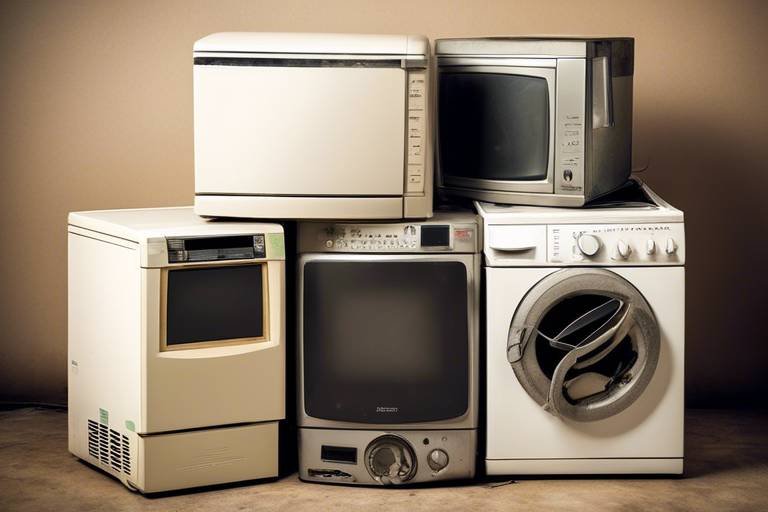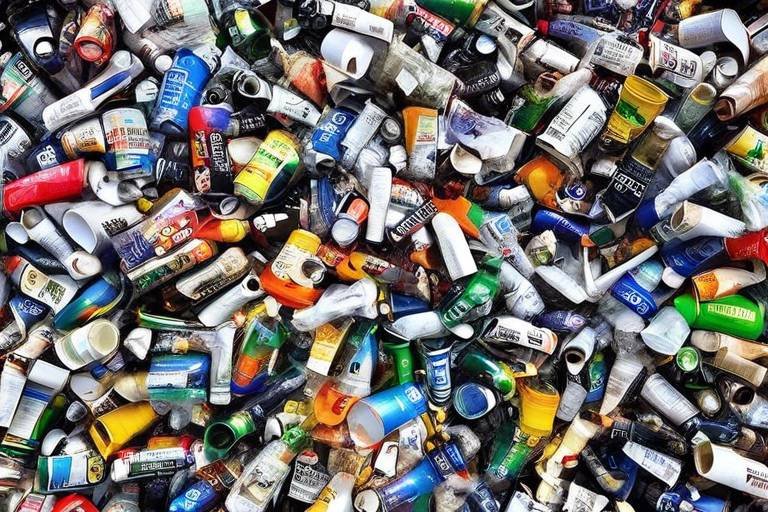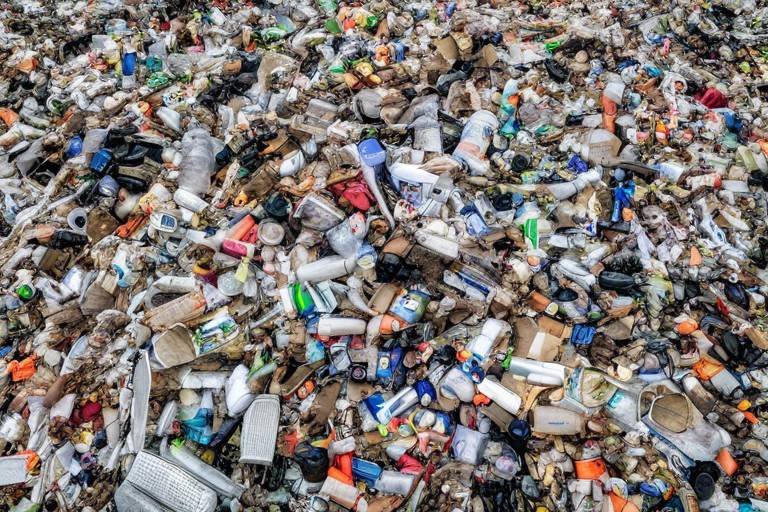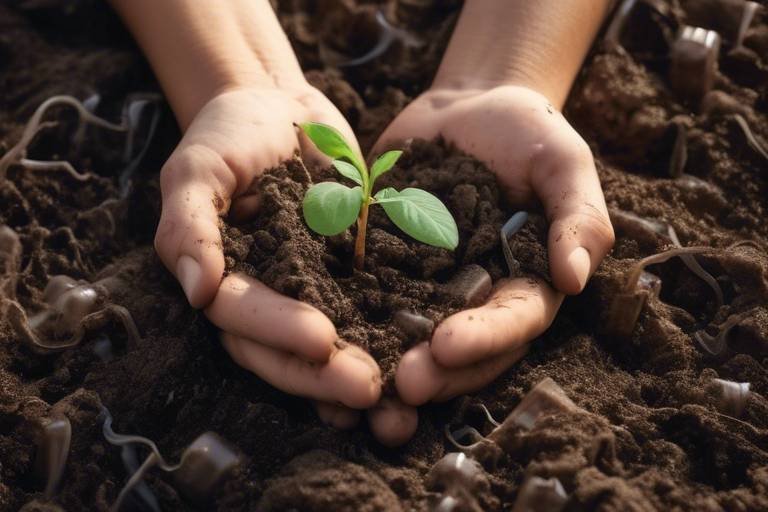The Journey of Recyclable Materials from Your Bin to New Products
Have you ever stopped to consider where your recyclable materials go after you toss them into the bin? It’s a fascinating journey that begins in your home and ends with the creation of new products. As we become increasingly aware of our environmental responsibilities, understanding this journey is not just interesting—it's essential. Recycling is more than just a buzzword; it’s a lifeline for our planet, reducing waste, conserving resources, and promoting sustainability. So, let’s dive into the intricate process that transforms your everyday waste into valuable resources.
The recycling journey starts right at your doorstep. When you separate your recyclables from regular trash, you’re taking the first step in a larger system aimed at minimizing our ecological footprint. Imagine your discarded plastic bottles, aluminum cans, and newspapers being collected and sent off on a new adventure, one that ultimately leads to the creation of new products. This process is a testament to the power of community and individual action in combating environmental issues.
As we explore this journey, it’s important to remember that recycling is not a one-size-fits-all solution. Different materials require different handling methods, and each type of recyclable material has its own unique properties that dictate how it can be processed. From the shiny, smooth surface of metals to the porous nature of paper, understanding these differences is crucial for effective recycling. It’s like a puzzle, where each piece plays a vital role in the bigger picture of sustainability.
So, what happens after your recyclables are collected? They are taken to processing facilities where they undergo meticulous sorting and processing. This stage is where the magic truly happens, as advanced technologies and skilled workers work together to separate materials based on their type and quality. The end result? High-quality raw materials that can be used to create everything from new packaging to eco-friendly products. It’s a cycle of renewal that demonstrates how our waste can be transformed into something valuable, reducing the need for new resources.
In the following sections, we will delve deeper into the recycling process, the types of materials that can be recycled, and the innovations that are shaping the future of recycling. Each step in this journey is crucial, and understanding it can empower us to make better choices for our planet. So, are you ready to explore the incredible journey of recyclable materials from your bin to new products? Let’s get started!
- What materials can be recycled? Most communities accept paper, cardboard, plastics, metals, and glass. However, it's essential to check local guidelines as they can vary.
- How does recycling help the environment? Recycling reduces landfill waste, conserves natural resources, saves energy, and decreases greenhouse gas emissions.
- Can recycling actually create new products? Absolutely! Recycled materials are often used to create new products, such as clothing, furniture, and packaging.
- What happens to items that can’t be recycled? Non-recyclable items typically end up in landfills, which can contribute to environmental pollution and resource depletion.

The Recycling Process Explained
Understanding the recycling process is crucial for effective waste management and sustainability. It’s not just about tossing your plastic bottle into the blue bin and hoping for the best. There’s a fascinating journey that these recyclable materials embark on, transforming from your everyday waste into new products. Let’s break down this process step-by-step, highlighting how each stage plays a vital role in the overall recycling effort.
The recycling process begins with collection. This is where all the magic starts. Recyclables are gathered from various sources, including homes, businesses, and public spaces. Depending on the locality, collection methods can vary significantly. For instance, some areas rely on curbside pickup, where waste management trucks come to your door, while others might have drop-off centers where you can bring your recyclables at your convenience. Each method has its benefits and is essential in encouraging community participation in recycling efforts.
Once the materials are collected, they are transported to a recycling facility. This is where the real sorting begins. The collected materials are dumped onto a conveyor belt, where workers and machines work together to separate them into different categories. This sorting process is crucial because mixing materials can contaminate the recyclables, making them unsuitable for processing. For example, if glass and plastic are mixed, it can lead to significant challenges in recycling. Here’s a quick overview of the materials typically sorted:
| Material Type | Recycling Method |
|---|---|
| Paper | Shredded, pulped, and processed into new paper products. |
| Plastics | Shredded and melted down to create new plastic items. |
| Metals | Shredded and melted for reuse in manufacturing. |
| Glass | Crushed and melted to form new glass products. |
After sorting, the next stage is processing. This involves cleaning and preparing the materials for manufacturing. For instance, plastics are often washed to remove labels and contaminants, while metals are melted down to remove impurities. This stage is crucial because it ensures that the recycled materials are of high quality, ready to be transformed into new products. Without this meticulous processing, the end products may not meet the necessary standards for safety and durability.
Finally, the processed materials are sold to manufacturers who will use them to create new products. This could be anything from recycled paper products to new plastic containers or even construction materials. The whole process not only conserves resources but also significantly reduces the amount of waste sent to landfills. It’s a win-win situation for both the environment and the economy!
So, the next time you toss something into your recycling bin, remember that it’s not just waste; it’s a resource that has the potential to be reborn as something new. The recycling process may seem straightforward, but it’s a complex system that requires cooperation, technology, and a commitment to sustainability.

When we think about recycling, it's easy to imagine a simple process where we toss our trash into a bin and forget about it. However, the reality is much more complex and fascinating! Different materials require unique recycling methods, and understanding these categories can help us become better recyclers. Let's dive into the various types of recyclable materials, their properties, and the challenges associated with recycling them.
The most common recyclable materials include paper, plastics, metals, and glass. Each of these categories has its own set of characteristics that influence how they are processed. For instance, paper is biodegradable and can be recycled multiple times, but it requires specific handling to avoid contamination from food or moisture. On the other hand, plastics are notorious for their complexity. With various types, such as PET and HDPE, each type has a distinct recycling process, and not all plastics are equally recyclable.
Let’s break this down a bit further:
- Paper: This includes newspapers, cardboard, and office paper. It’s essential to keep it clean and dry, as contamination can hinder the recycling process.
- Plastics: Plastics are categorized by numbers (1-7) that indicate their resin type. For example, PET (1) is widely recycled, while others like PVC (3) are less commonly accepted.
- Metals: Aluminum cans and tin cans are highly recyclable. They can be melted down and reformed indefinitely without losing quality.
- Glass: Glass bottles and jars can be recycled repeatedly. However, they need to be sorted by color, which adds a layer of complexity to the recycling process.
Understanding these categories not only helps us recycle effectively but also highlights the importance of proper sorting and contamination prevention. For example, if a pizza box is thrown into the paper recycling bin, it can ruin an entire batch of paper due to grease contamination. Therefore, being mindful of what we place in our recycling bins is crucial.
In addition to the common materials mentioned above, there are also specialty recyclables such as electronics, batteries, and textiles. These items often require specific recycling programs due to their hazardous components or complex materials. For instance, electronic waste (e-waste) contains precious metals that can be recovered, but it also has toxic substances that need to be handled carefully.
Moreover, the recycling industry is constantly evolving, and innovations are emerging to tackle these challenges. With advancements in technology, we are seeing new methods for recycling materials that were once considered non-recyclable. This not only improves efficiency but also enhances the overall sustainability of our recycling efforts.
In conclusion, recognizing the different types of recyclable materials and their unique properties is essential for effective recycling. By doing so, we can contribute to a more sustainable future and ensure that valuable resources are not wasted but instead transformed into new products. Remember, every little effort counts!
Q: What types of plastics can be recycled?
A: Most curbside recycling programs accept plastics numbered 1 (PETE) and 2 (HDPE). Some may also accept 5 (PP), but it's best to check with your local recycling guidelines.
Q: Can I recycle pizza boxes?
A: If the pizza box is clean and free of grease, it can be recycled. However, if it has grease stains, it should be disposed of in the trash.
Q: How can I find a recycling center near me?
A: You can visit your city’s waste management website or use online resources like Earth911 to locate nearby recycling centers.

When it comes to recycling, the journey of your recyclable materials begins with the crucial step of collection. Understanding the various collection methods is essential for maximizing participation in recycling programs and ensuring that materials are properly diverted from landfills. There are several effective ways to collect recyclables, each with its own unique advantages and challenges.
One of the most common methods is curbside pickup. This convenient service allows residents to place their recyclables in designated bins at the curb for collection by waste management services. Curbside recycling programs are designed to make it easy for households to participate, as they simply need to follow a schedule and prepare their materials for pickup. The benefits of curbside recycling are significant, including increased convenience for residents and higher overall participation rates. However, it is vital for residents to understand the guidelines on what can and cannot be recycled to avoid contamination, which can undermine the entire recycling process.
Another important method is the use of drop-off recycling centers. These facilities provide an alternative for individuals who may not have access to curbside services or for those who prefer to take their recyclables directly to a center. Drop-off centers are typically located in easily accessible areas, such as community centers or grocery store parking lots, making them a practical option for many. They serve as a vital resource, especially in areas where curbside pickup is not available or where residents generate a higher volume of recyclable materials. The operational logistics of these centers often involve designated bins for different materials, allowing for better sorting and processing of recyclables.
Additionally, community recycling programs play a significant role in the collection of recyclables. These programs often involve local organizations and volunteers who work together to promote recycling initiatives within neighborhoods. They may host events, such as recycling drives or educational workshops, aimed at raising awareness about the importance of recycling and providing residents with the tools they need to recycle effectively. By fostering a sense of community involvement and responsibility, these programs can lead to increased participation and a greater understanding of recycling practices.
To summarize, effective collection methods are the backbone of successful recycling efforts. Whether through curbside pickup, drop-off centers, or community programs, each method contributes to the overall goal of reducing waste and promoting sustainability. The key to a successful recycling initiative lies in public participation and education. By understanding the various collection methods available, individuals can make informed choices about how to properly dispose of their recyclable materials, ultimately benefiting the environment.

Curbside recycling programs are a cornerstone of modern waste management, designed to make recycling as easy and accessible as possible for households. Imagine this: every week, you place your recycling bin out on the curb, and like magic, it gets whisked away to contribute to a cleaner planet. But what happens next? These programs are not just about throwing recyclables into a bin; they are a vital link in the chain of sustainability. They encourage participation by removing barriers to recycling, making it a seamless part of our weekly routines.
So, how do these programs work? Typically, residents are provided with designated bins for recyclables, which are collected on a scheduled basis—often weekly. The convenience of curbside pickup means that people are more likely to participate, leading to higher rates of recycling in communities. Just think about it: when recycling is as easy as taking out the trash, more people will do it!
Moreover, the success of curbside recycling relies heavily on public participation. Community education plays a crucial role in ensuring that residents know what can and cannot be recycled. Many programs provide guidelines, often displayed on the bins themselves, to help reduce contamination. Contaminated recyclables can lead to entire loads being sent to landfills, which defeats the purpose of recycling. Therefore, understanding the dos and don’ts of curbside recycling is essential for maximizing effectiveness.
Here are some common items that are typically accepted in curbside recycling programs:
- Papers: Newspaper, magazines, and office paper.
- Plastics: Bottles and containers marked with recycling symbols #1 and #2.
- Metals: Aluminum cans and tin cans.
- Glass: Clear, green, and brown glass bottles and jars.
While curbside recycling programs are a fantastic initiative, they are not without challenges. One significant issue is the varying guidelines across different municipalities. What one city accepts might differ from another, leading to confusion among residents. Thus, it's essential for local governments to provide clear and consistent information to their communities.
In conclusion, curbside recycling programs are a practical and effective way to encourage recycling and promote sustainability. By making recycling easy and accessible, these programs not only help reduce waste but also foster a sense of community responsibility towards the environment. The more we participate, the more we contribute to a greener future.
Q: What can I recycle in my curbside bin?
A: Most curbside recycling programs accept paper, plastics marked #1 and #2, aluminum cans, and glass bottles. Always check your local guidelines for specifics.
Q: What happens if I put a non-recyclable item in my bin?
A: Non-recyclable items can contaminate the recycling stream, potentially causing entire loads to be sent to landfills. It’s crucial to follow the recycling guidelines provided by your local program.
Q: How can I get involved if my community doesn’t have a curbside program?
A: You can advocate for a curbside recycling program by attending community meetings, reaching out to local representatives, or organizing a petition to demonstrate public interest.

Drop-off recycling centers play a vital role in the recycling ecosystem, offering an alternative for individuals who may not have access to curbside collection services. These centers are strategically located throughout communities, making it easier for residents to dispose of their recyclable materials responsibly. Imagine a bustling hub where people gather, armed with their bags of recyclable items, eager to contribute to a cleaner planet. This is the essence of a drop-off recycling center.
One of the primary advantages of drop-off centers is their flexibility. Unlike curbside programs that operate on specific schedules, these centers are often open during extended hours, allowing individuals to recycle at their convenience. This accessibility encourages more people to participate in recycling efforts, significantly increasing the volume of materials diverted from landfills. In fact, many centers have reported a rise in participation as awareness grows about the importance of recycling.
Moreover, drop-off centers often accept a wider variety of materials compared to curbside pickup. While curbside programs may have restrictions on what can be collected, drop-off centers typically accommodate items such as:
- Electronics (e-waste)
- Hazardous waste (like batteries and paint)
- Larger items (like appliances and furniture)
This inclusivity not only helps in reducing waste but also ensures that materials that require special handling are disposed of properly. However, it’s essential for users to familiarize themselves with the specific guidelines of their local drop-off center to ensure that they are recycling correctly and not inadvertently contaminating recyclable materials with non-recyclables.
Operational logistics at these centers are designed to streamline the recycling process. Most drop-off centers are equipped with designated bins for different materials, which helps in maintaining cleanliness and efficiency. Additionally, many centers have staff on hand to assist visitors, answer questions, and provide guidance on what can and cannot be recycled. This human touch not only enhances the experience but also fosters a sense of community responsibility towards recycling.
In summary, drop-off recycling centers are an essential component of the recycling framework. They provide a practical solution for individuals who may not benefit from curbside services, promote community engagement, and ensure a broader range of materials are recycled. By utilizing these centers, we can collectively take significant strides toward a more sustainable future.
- What materials can I recycle at drop-off centers? Most centers accept paper, plastics, metals, glass, and sometimes electronics and hazardous waste. Always check local guidelines.
- Are drop-off recycling centers open year-round? Many centers are open year-round, but hours may vary. It's best to check with your local facility for specific hours of operation.
- Is there a fee to use drop-off recycling centers? Most drop-off centers are free to use, but some may charge fees for specific items, especially e-waste.

Once recyclables are collected, the next critical step in the recycling journey is sorting and processing. This phase is essential for ensuring that materials are properly categorized and prepared for recycling. Imagine a bustling factory floor where dedicated workers and advanced machines collaborate to sort through the heaps of collected materials. It’s like a well-orchestrated dance, where each participant plays a vital role in keeping the rhythm of recycling alive.
The sorting process typically begins at a recycling facility, where materials are dumped onto a conveyor belt. Here, manual labor and technology work hand in hand. Workers are trained to identify different types of materials, removing contaminants and non-recyclables that could disrupt the recycling flow. This initial sorting is crucial because contamination can lead to entire batches of recyclables being rejected, which defeats the purpose of recycling.
But it doesn't stop there! Advanced technologies, such as optical scanners and magnetic separators, also play a significant role in this process. Optical scanners can identify specific types of plastics and separate them based on their resin types, while magnetic separators can efficiently pull out metals from the mix. This tech-savvy approach not only enhances efficiency but also increases the quality of the recycled materials.
Once sorted, the materials undergo further processing. For example, paper is shredded and mixed with water to create a slurry, while plastics are washed, melted, and molded into pellets. These processed materials are then ready to be transformed into new products. This step is akin to a caterpillar turning into a butterfly—what was once waste is now a valuable resource!
To give you a clearer picture, here’s a simple table that outlines the sorting and processing steps for common recyclable materials:
| Material Type | Sorting Method | Processing Method |
|---|---|---|
| Paper | Manual sorting and shredding | Mixed with water to create pulp |
| Plastics | Optical scanning and manual sorting | Washed, melted, and formed into pellets |
| Metals | Magnetic separation | Shredded and melted for reuse |
| Glass | Color sorting and manual inspection | Crushed and melted to form new glass products |
This meticulous sorting and processing not only ensures that we maximize the potential of recyclable materials but also underscores the importance of community participation in the recycling process. By being mindful of what we toss into our bins, we can help streamline these operations and contribute to a more sustainable future.

Recycling facilities play a crucial role in the recycling ecosystem, acting as the bridge between collected materials and their transformation into new products. These facilities are equipped with specialized machinery and skilled personnel who work tirelessly to ensure that recyclable materials are processed efficiently and effectively. Without these facilities, the recycling process would be hindered, and the potential benefits of recycling would be lost.
At the heart of a recycling facility's operations is the sorting process. Once materials are collected from curbside pickups or drop-off centers, they arrive at the facility where they are sorted into various categories. This sorting is essential because different materials require different processing techniques. For example, metals are often melted down, while plastics may be shredded and reformed. The sorting process can be both manual and automated, utilizing advanced technologies like conveyor belts and optical scanners to enhance accuracy and speed.
After sorting, the next step involves processing the materials. This can include cleaning, shredding, and compacting the recyclables. For instance, glass is crushed into small pieces, which are then melted to create new glass products. The efficiency of these processes is vital, as it determines the quality of the recycled material and its suitability for reuse in manufacturing. Recycling facilities are also responsible for ensuring that contaminants—such as food waste or non-recyclable items—are removed, as these can compromise the integrity of the recycled products.
Moreover, recycling facilities contribute significantly to the local economy. They create jobs and promote community engagement by educating the public about the importance of recycling. Many facilities offer tours and workshops to raise awareness about sustainability and the impact of waste on the environment. The more people understand the recycling process, the more likely they are to participate actively, which ultimately leads to increased recycling rates.
In addition to processing materials, recycling facilities also play a role in the innovation of recycling technologies. As the demand for recycled products grows, these facilities are continuously adapting and upgrading their systems to improve efficiency and reduce costs. This not only helps in maximizing the recovery of valuable materials but also in minimizing the environmental footprint of the recycling process.
In summary, recycling facilities are not just processing plants; they are vital components of a sustainable future. They ensure that materials are recycled properly, contribute to economic growth, and promote environmental stewardship. As we continue to face challenges related to waste management and resource depletion, the importance of these facilities cannot be overstated. They are the unsung heroes in our quest for a cleaner, greener planet.
- What types of materials can be recycled at recycling facilities? Most facilities accept paper, plastics, metals, and glass, but it's essential to check with your local facility for specific guidelines.
- How does the sorting process work? Materials are sorted using a combination of manual labor and automated systems that identify and separate different types of recyclables.
- Can I drop off my recyclables at the facility? Many recycling facilities have drop-off options for community members who prefer not to use curbside pickup services.
- What happens to my recyclables after they are processed? After processing, the materials are sold to manufacturers who use them to create new products, thus completing the recycling loop.

The impact of recycling on our environment is nothing short of transformative. When we think about the mountains of waste that pile up in landfills, it’s easy to feel overwhelmed. However, recycling offers a beacon of hope. By diverting materials from landfills, we not only reduce the physical space required for waste but also mitigate the harmful effects associated with waste decomposition, such as methane emissions. Did you know that recycling just one ton of paper can save about 17 trees? Imagine the forests we could protect if everyone committed to recycling!
Recycling also plays a critical role in conserving natural resources. By reusing materials, we decrease the need for virgin resources, which often require extensive mining, drilling, or harvesting. For instance, recycling aluminum saves up to 95% of the energy needed to produce new aluminum from raw materials. This energy conservation is crucial, especially in our fight against climate change. In fact, the energy saved from recycling one glass bottle can power a light bulb for four hours!
Furthermore, recycling significantly reduces carbon emissions. According to the Environmental Protection Agency (EPA), recycling and composting prevented the release of 186 million metric tons of carbon dioxide equivalent into the air in 2013 alone. This is equivalent to taking 39 million cars off the road for a year! By lowering greenhouse gas emissions, we contribute to cleaner air and a healthier planet.
To illustrate the environmental benefits of recycling, consider the following table that summarizes the impacts of recycling various materials:
| Material | Energy Saved (compared to virgin production) | CO2 Emissions Reduced |
|---|---|---|
| Aluminum | 95% | 1 ton per ton recycled |
| Paper | 60% | 1.7 tons per ton recycled |
| Glass | 30% | 0.2 tons per ton recycled |
| Plastic | 70% | 1.5 tons per ton recycled |
As we can see, the benefits of recycling extend far beyond just reducing waste. It creates a ripple effect that positively influences our air quality, conserves energy, and protects our precious natural resources. However, it’s essential to remember that recycling is not a standalone solution. It must be part of a larger strategy that includes reducing consumption and reusing materials whenever possible.
In conclusion, the impact of recycling on the environment is profound and multifaceted. By embracing recycling, we not only contribute to a cleaner planet but also foster a sustainable future for generations to come. Every small effort counts, and together, we can make a significant difference!
- What materials can be recycled? Most common materials include paper, cardboard, glass, metals, and certain plastics. Always check local guidelines for specifics.
- How does recycling help combat climate change? Recycling reduces the need for new materials, saving energy and lowering greenhouse gas emissions.
- Can I recycle contaminated materials? Contaminated items, like greasy pizza boxes, often cannot be recycled as they can spoil the recycling process.
- What can I do to improve my recycling habits? Educate yourself on local recycling rules, reduce waste, and make a habit of sorting recyclables at home.

In recent years, the landscape of recycling has undergone a remarkable transformation, thanks to innovations in technology. These advancements are not just about making the recycling process more efficient; they are about redefining how we think about waste and sustainability. Imagine a world where every piece of plastic, metal, or paper you throw away could be reborn into something new, all thanks to cutting-edge technology. This is not a distant dream; it’s happening right now!
One of the most exciting developments is the use of artificial intelligence (AI) in sorting recyclable materials. AI systems can quickly and accurately identify different types of materials, significantly reducing the time and labor required in traditional sorting processes. For example, AI-powered robots can scan a stream of waste and separate recyclables with incredible precision. This not only enhances the quality of the recycled materials but also maximizes the amount of waste that can be diverted from landfills.
Another groundbreaking innovation is the introduction of advanced shredding and granulation technologies. These machines can process materials at a microscopic level, breaking down plastics and metals into smaller particles. This process not only improves the efficiency of recycling but also enables the recovery of valuable resources that were previously too difficult to extract. By turning waste into tiny particles, manufacturers can create new products with a much lower environmental footprint.
Additionally, the emergence of biodegradable plastics and chemical recycling is changing the game. Traditional recycling methods often struggle with certain types of plastics, leading to a significant amount of waste. However, chemical recycling breaks down plastics into their original monomers, allowing them to be reused in the production of new plastics. This process not only reduces waste but also conserves valuable resources needed to create new materials.
Moreover, the adoption of blockchain technology in recycling is gaining traction. This technology provides a transparent, secure way to track recyclable materials from collection to processing. By ensuring that materials are handled responsibly, blockchain can enhance trust in the recycling process, encouraging more people to participate. Imagine knowing exactly where your recyclables end up and how they are transformed—this level of transparency could revolutionize public engagement in recycling initiatives.
As we continue to innovate, the potential for recycling to contribute to a sustainable future is enormous. The integration of these technologies not only improves efficiency but also promotes a circular economy, where resources are continuously reused rather than discarded. By embracing these advancements, we can create a more sustainable world, where waste is minimized, and every material has a second life.
- What is the role of AI in recycling? AI helps in sorting recyclable materials more efficiently and accurately, enhancing the overall recycling process.
- How does chemical recycling work? Chemical recycling breaks down plastics into their original components, allowing for the creation of new plastics from recycled materials.
- What are biodegradable plastics? Biodegradable plastics are designed to decompose naturally over time, reducing plastic waste in the environment.
- How can blockchain improve recycling? Blockchain technology provides transparency in the recycling process, tracking materials from collection to processing and ensuring responsible handling.

The concept of a circular economy is revolutionizing the way we think about waste and resource management. Unlike the traditional linear economy, where products are made, used, and then discarded, a circular economy aims to keep resources in use for as long as possible. This model emphasizes the importance of recycling as a fundamental practice in sustaining our environment. By creating a closed-loop system, we can significantly reduce the amount of waste that ends up in landfills and promote a more sustainable way of living.
In a circular economy, recycling is not merely an option; it is a necessity. It transforms waste into valuable resources, allowing materials to be reused and repurposed. Imagine a world where your old plastic bottles could be turned into new clothing or where discarded electronics are transformed into new gadgets. This is the power of recycling within a circular economy. It encourages innovation and creativity in how we view waste.
One of the key benefits of integrating recycling into a circular economy is the reduction of environmental impact. By recycling materials, we can:
- Minimize the extraction of raw materials, which often leads to habitat destruction and pollution.
- Save energy, as recycling typically requires less energy than producing new products from virgin materials.
- Lower greenhouse gas emissions, contributing to the fight against climate change.
Moreover, the circular economy promotes resource efficiency. Companies are encouraged to design products with their end-of-life in mind, making them easier to recycle or repurpose. This not only helps reduce waste but also fosters a culture of sustainability among consumers. When individuals are aware of how their purchasing decisions impact the environment, they are more likely to choose products that support a circular economy.
However, transitioning to a circular economy is not without its challenges. It requires collaboration between governments, businesses, and consumers. Policies must be put in place to incentivize recycling and sustainable practices, while businesses need to innovate in product design and supply chain management. Consumers, on the other hand, play a crucial role by participating in recycling programs and making informed choices.
In conclusion, the integration of recycling into the circular economy is essential for creating a sustainable future. It allows us to rethink our relationship with waste and encourages us to see the potential in what we often consider trash. By embracing this model, we can pave the way for a healthier planet, ensuring that resources are available for future generations.
1. What is a circular economy?
A circular economy is an economic system aimed at eliminating waste and the continual use of resources. It contrasts with the traditional linear economy, which follows a 'take, make, dispose' model.
2. How does recycling fit into the circular economy?
Recycling is a key component of the circular economy as it allows materials to be reused and repurposed, reducing the need for new raw materials and minimizing waste.
3. What are the benefits of a circular economy?
The benefits include reduced environmental impact, conservation of resources, energy savings, and the promotion of sustainable practices among businesses and consumers.
4. What can individuals do to support a circular economy?
Individuals can support a circular economy by participating in recycling programs, making informed purchasing decisions, and advocating for sustainable practices in their communities.
Frequently Asked Questions
- What materials can be recycled?
You can recycle a variety of materials including paper, plastics, metals, and glass. Each type has its own recycling process, so it's important to know what can go into your recycling bin to ensure effective recycling.
- How does the recycling process work?
The recycling process typically involves several steps: collection, sorting, processing, and then transforming materials into new products. It starts with gathering recyclables, which are then sorted by type, cleaned, and processed into raw materials that manufacturers can use to create new items.
- What are curbside recycling programs?
Curbside recycling programs are convenient services that allow residents to place their recyclables in special bins for collection right at their homes. This makes it easier for people to participate in recycling without needing to travel to drop-off centers.
- What is the importance of recycling facilities?
Recycling facilities play a crucial role in the recycling ecosystem. They are equipped with machinery and technology to sort and process recyclable materials efficiently, ensuring that they are transformed into reusable resources that can reduce waste and conserve energy.
- How does recycling benefit the environment?
Recycling has significant environmental benefits, including reducing landfill waste, saving energy, and lowering carbon emissions. By recycling, we conserve natural resources and help mitigate the impact of waste on our planet.
- What innovations are currently impacting recycling technology?
Innovations in recycling technology, such as improved sorting systems and advanced processing methods, are enhancing the efficiency of recycling operations. These advancements help recover more materials and promote sustainable practices within the waste management industry.
- What is a circular economy?
A circular economy is an economic model that emphasizes sustainability by promoting the continuous reuse of resources. Recycling is a key component of this model as it encourages the efficient use of materials and reduces environmental impact through ongoing resource recovery.



